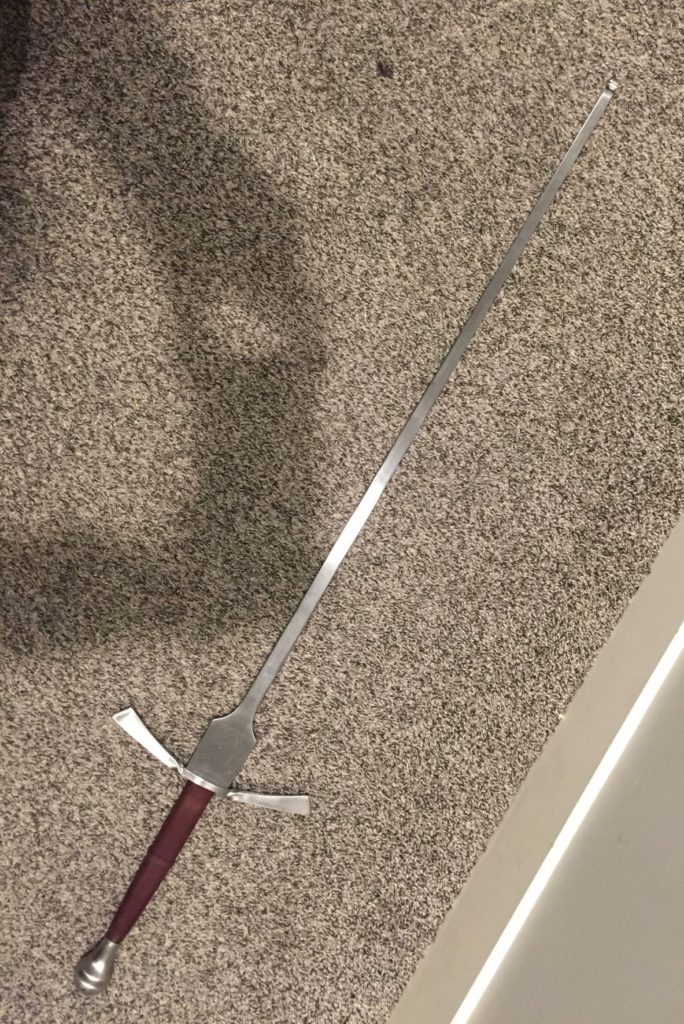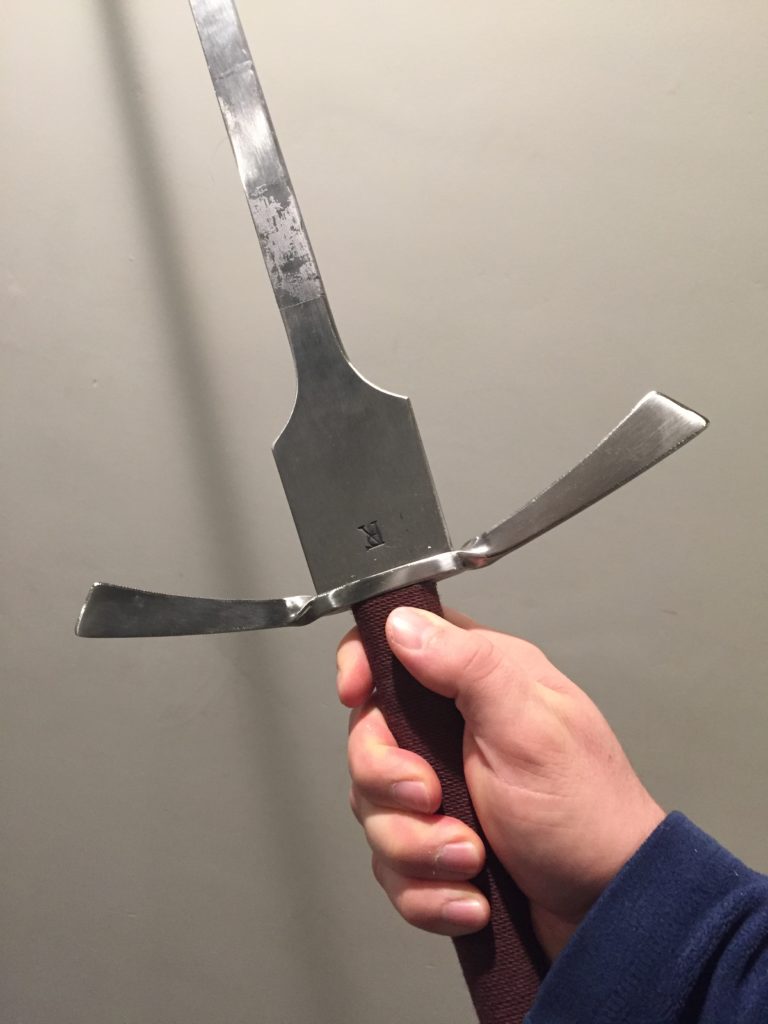The modern training sword, or feder, as most people who practice longsword call their training weapons, serves as one of the keys to training in historical European martial arts. Without a good training weapon it’s very difficult to learn technique correctly, and the subtleties of correct execution will get lost. Unfortunately the market for training swords has recently developed two trends that concern me. First, some lines of training swords are becoming more and more “sportified”, becoming too flexible, too light, too long, and too divorced from the source material they are supposedly trying to emulate in the name of safety, or, worse, ease. Second, there are at least three broad categories for longswords, and many more for other varieties of swords. Little effort is being put into replicating all of these varieties, the focus remains on training tools that best suit the context of tournament rule sets. The only solution is for we as a community to ask more of our training weapon providers to meet these needs.
The tournament scene for historical European martial arts has become more and more competitive, and this has been a good thing up to now. HEMA has thrived on competition, but for some competition has become the goal. For those who run competitions the risks of holding a martial arts tournament, namely injury to the participants, has lead to standard equipment requirements. This, in and of itself, is okay. Standard safety equipment, helmets, gauntlets, gorgets, etc… is just good sense when in a competitive environment. European warriors often used specially made tournament armor. What concerns me is the restrictions on different weapons, armor, and approved makers lists. More than that, the approved lists for some tournaments seem to favor less historical and less accurate training weapons, which seem to some, ostensibly “safer.” I dispute that, and would love to see some actual data collected on the injury rate resulting from the use of certain training weapons before they are excluded from broad use in tournaments. I believe that the trend of current restrictions are largely the result of subjective perception, and do not actually make us safer.
Seriously though, banning the Albion Liechtenauer, because it’s “heavier” is nonsense. Ruling in favor of, and worse, endorsing, whippy training swords with no serious research behind them, that match only a very narrow range of dimensions, and fail to replicate both the weight and feel of historical longswords, all for some, at most, marginal level of increased “safeness” is bad for the art and community as a whole. That way lies sport fencing. I argue quite strongly in my book that we must be careful about standardizing our tournament rules, and that includes equipment rules. We must be more mindful about creating requirements and rules that depart too much from the historical precedents. My club’s injury rate is remarkably low, zero serious injuries since 2009, when I started it, we spar with several rule sets, but our favorite is an interpretation of the medieval rule set, each fighter gets a certain number of attacks, usually 4-7, and the best blow, judged by various criteria, wins. We go full speed, often taking multiple hits in a round. We don’t ban any training weapons unless they have edges or points that would be distinctly unsafe and accident prone. Assuming standard safety gear, banning a well designed training weapon, doesn’t achieve a superior level of safeness, and my club’s record is proof of that.
If we want to make our arts and sports safer, then what we should do instead is promote a culture of control in the HEMA community. We should value the capacity to restrain our strikes when needed and train accordingly. I spend the first several months I have with a new student emphasizing control training with my students, and I believe that every group should. You should spend time laying the safety equipment aside and train your club to develop and rely on control. My club is proof that this not only achieves an admirable level of safety, but that it translates into not needing stringent rules and restrictions in sparring and training that ignore historical accuracy. We can go faster and harder without injuring each other because we put in the hard work to learn how to keep our heads in the game. Do we have bumps and bruises? Sure, but we never have broken bones. We never have concussions. We never have any trips to the emergency room. Frankly if you’re not willing to endure bruises then you shouldn’t be practicing a martial art in the first place.
Relying on “safe” training weapons to achieve safety is a fallacy. In the same way that overparenting can produce rebellious kids, overemphasizing safety through equipment, and not demanding that our students develop physical discipline leads to dangerous training partners. Martial arts distill violence into a concentrated form. If someone executes a technique of distilled violence against you with no restraint they risk doing you serious harm, safety equipment or no safety equipment. Safety is principally achieved with control, not equipment. We need to start paying more attention to how and why competition was done in the past, and start asking hard questions about how we are going to try to live up to that standard, and the answer isn’t to invent safety equipment that fails to behave like decent simulations of real weapons.
My second concern is lack of attention to historical accuracy in designing swords and training swords. Most of the swords and training swords made in the twentieth century were simply too heavy, poorly balanced, and poorly researched. This led to many of the stereotypes that we are constantly trying to disabuse the public of today. I think, however, that the pendulum has swung too far in the other direction when it comes to swordmakers who cater to the HEMA community. There is quite a variety of weights, balances, and designs in ancient weaponry, and perhaps two dozen meaningfully different designs and contexts from the Viking era through to the Early Modern period. When we look at the training tools on offer though, not only do we see a very limited set of swords being replicated, but we see very little serious work replicating the weight, length, balance and feel of historical weaponry. Not only that, but the current competition trends favor weapons that are advantageous to larger and stronger people. Some of the young women in my club are just too short to be able to use three quarters or more of the training weapons out there. There is a significant percentage of the population of interested people that are underserved by current trends. You have to custom order training swords to get weapons that work properly for them.
Here’s one example, many of the modern training swords are just plain too long in both blade and handle, and too light for proper weapons of those lengths. This is both a function of the fact that our protective equipment, especially the gloves, are too big, and the fact that most beginners have trouble understanding how to take advantage of the features of smaller swords. The HEMA community doesn’t yet have the critical mass of thoroughly qualified instructors needed to reliably overcome the incorrect intuitions that have become common in the community at the local level. We have a long ways to go in educating our students, researching historical sword designs, and translating that research into replica swords and training swords.
Frankly, we need to be banning training weapons that don’t meet minimum standards of historical accuracy. If someone enters a longword tournament with a 54″ sword that comes above their shoulder, and weighs a mere 2.5 lbs, they should be offered a more accurate piece of equipment to use instead. Now, I think this should be a weapon-by-weapon kind of decision. Sometimes a maker will have a really good offering and a really bad offering. For example, I absolutely love SIGI’s short swords. Those seem to be very strong offerings for sword and buckler work. They are an excellent simulator for a Type XV arming sword. Their longswords, however, are too long and too flexible. They use very similar design philosophies between the two categories of weapons, but it is effective in one case and ineffective in another.
I call on modern makers to, as my old math teacher said, “show your work.” Prove that you did your homework and designed your training swords to historical standards. Researchers are putting together more and more publicly available work for recreating accurate swords and training swords. We as a community need to use it. We need to do the design work, the research, and most importantly we need to pay attention and buy stuff that benefits from it. If we do that then in another ten years we’ll have not only wider offerings, but better quality, and better understanding of what good quality is for the many given sword designs, and our arts will be better for it.

